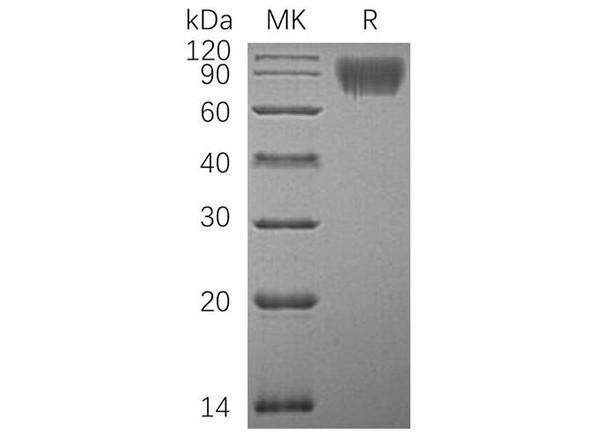Description
| Product Name: | Human ICAM-1 Recombinant Protein |
| Product Code: | RPPB3724 |
| Size: | 10µg |
| Species: | Human |
| Target: | ICAM-1 |
| Synonyms: | Intercellular adhesion molecule 1, ICAM-1, Major group rhinovirus receptor, CD54 antigen, ICAM1, BB2, CD54, P3.58. |
| Source: | Escherichia Coli |
| Physical Appearance: | Sterile Filtered clear solution. |
| Formulation: | ICAM-1 is supplied (0.2mg/ml) in PBS, 50% Glycerol, 2mM Imidazole. |
| Stability: | Store at 4°C if entire vial will be used within 1-2 weeks.�Store, frozen at -20°C for longer periods of time.�Avoid multiple freeze-thaw cycles. |
| Purity: | Greater than 95% as determined by SDS-PAGE. |
ICAM-1 also called CD54 is a single chain membrane glycoprotein expressed on the surface of a variety of non-haematopoietic and haematopoietic cell types and has roles in signal transduction, cell signaling and lymphocyte adhesion. ICAM1 binds to integrins such as CD11a / CD18, or CD11b / CD18. ICAM1 is also used by Rhinovirus as a receptor. ICAM-1 is an intercellular adhesion molecule constantly present in low concentrations in the membranes of leukocytes and endothelial cells. When stimulated by cytokine the concentrations significantly increase. ICAM-1 can be stimulated by interleukin-1 (IL-1) and tumor necrosis factor alpha (TNFA) and is expressed by the vascular endothelium, macrophages and lymphocytes. ICAM-1 is a ligand for LFA-1 which is a receptor found on leukocytes. Upon activation, leukocytes bind to endothelial cells via ICAM-1/LFA-1 and then transmigrate into tissues.ICAM-1 is implicated in subarachnoid hemorrhage (SAH). Levels of ICAM-1 are shown to be notably elevated in patients with SAH. Soluble ICAM-1 is detectable in the plasma and is elevated in patients with various inflammatory conditions.
ICAM-1 Human Recombinant is expressed in E. coli containing 455 amino acids 28-483 fused to an amino terminal hexahistidine tag.The ICAM-1 is purified by proprietary chromatographic techniques.
| UniProt Protein Function: | ICAM1: a type I membrane protein of the immunoglobulin superfamily. Is a ligand for the leukocyte adhesion LFA-1 protein (Integrin alpha-L/beta-2) and a Rhinovirus receptor. Typically expressed on endothelial cells and cells of the immune system. ICAM1 binds to integrins of type CD11a / CD18, or CD11b / CD18. Its expression is activated by p53 in an NF-kappaB-independent manner. Induced by TNFalpha in a process that involves IKKbeta. |
| UniProt Protein Details: | Protein type:Immunoglobulin superfamily; Membrane protein, integral; Cell adhesion Chromosomal Location of Human Ortholog: 19p13.3-p13.2 Cellular Component: extracellular space; focal adhesion; cell surface; membrane; integral to plasma membrane; plasma membrane; immunological synapse; external side of plasma membrane Molecular Function:viral receptor activity; integrin binding; protein binding; transmembrane receptor activity; receptor activity Biological Process: entry of virus into host cell; extracellular matrix organization and biogenesis; positive regulation of nitric oxide biosynthetic process; T cell antigen processing and presentation; response to organic cyclic substance; activation of NF-kappaB transcription factor; positive regulation of cellular extravasation; regulation of cell shape; leukocyte adhesion; cellular response to nutrient levels; sensory perception of sound; ovarian follicle development; T cell activation via T cell receptor contact with antigen bound to MHC molecule on antigen presenting cell; membrane to membrane docking; response to sulfur dioxide; cell adhesion; regulation of leukocyte mediated cytotoxicity; acute inflammatory response to antigenic stimulus; response to drug; regulation of cell adhesion; virion attachment, binding of host cell surface receptor; negative regulation of calcium ion transport; regulation of immune response; cytokine and chemokine mediated signaling pathway; response to amphetamine; cell aging; response to amino acid stimulus; heterophilic cell adhesion; positive regulation of peptidyl-tyrosine phosphorylation; response to ethanol; response to copper ion; positive regulation of actin filament polymerization; positive regulation of vasoconstriction; adhesion to host; cell adhesion mediated by integrin; response to ionizing radiation; leukocyte migration Disease: Malaria, Susceptibility To |
| NCBI Summary: | This gene encodes a cell surface glycoprotein which is typically expressed on endothelial cells and cells of the immune system. It binds to integrins of type CD11a / CD18, or CD11b / CD18 and is also exploited by Rhinovirus as a receptor. [provided by RefSeq, Jul 2008] |
| UniProt Code: | P05362 |
| NCBI GenInfo Identifier: | 68067956 |
| NCBI Gene ID: | 3383 |
| NCBI Accession: | P05362.2 |
| UniProt Secondary Accession: | P05362,Q5NKV7, Q96B50, B2R6M3, |
| UniProt Related Accession: | P05362 |
| Molecular Weight: | |
| NCBI Full Name: | Intercellular adhesion molecule 1 |
| NCBI Synonym Full Names: | intercellular adhesion molecule 1 |
| NCBI Official Symbol: | ICAM1�� |
| NCBI Official Synonym Symbols: | BB2; CD54; P3.58�� |
| NCBI Protein Information: | intercellular adhesion molecule 1; ICAM-1; cell surface glycoprotein P3.58; major group rhinovirus receptor; intercellular adhesion molecule 1 (CD54), human rhinovirus receptor |
| UniProt Protein Name: | Intercellular adhesion molecule 1 |
| UniProt Synonym Protein Names: | Major group rhinovirus receptor; CD_antigen: CD54 |
| Protein Family: | Intercellular adhesion molecule |
| UniProt Gene Name: | ICAM1�� |
| UniProt Entry Name: | ICAM1_HUMAN |






